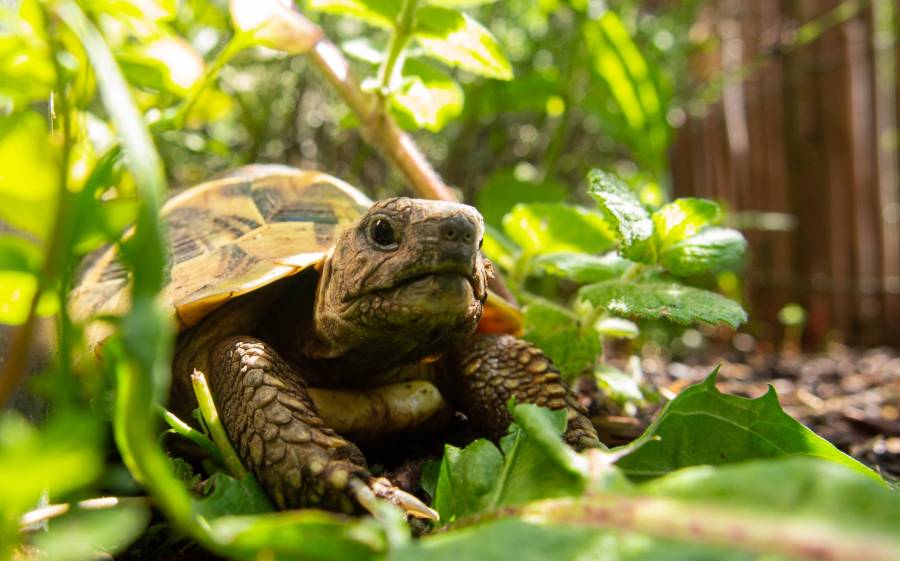Quick Navigation
A dangling white skin does look scary to most owners.
Depending on the type of turtle, it is understandable to be alarmed because peeled white skin does present some concern.
One of the primary concerns would be the potential spread of infection to other turtles or animals in the same habitat. A
nother concern would be the health of the turtle seen with the peeled white skin.

Turtles might be experiencing health issues when shedding skin, and their body language is the only way to express it.
Why Is Your Turtle Shedding White Skin?
1. Growth
Turtles do shed both their skin and their shell.
Similar to other reptiles, turtles need to shed as they grow.
Turtles do not have skin that expands; their skin is covered with plate-like scales.
The new skin or shell grows underneath, and the old one peels off as time passes.
The shedding of old skin also helps get rid of algae and other infections.
A turtle sheds in different stages, and they do not shed all of the old skin at once.
The peeling of white or transparent tissues can also be referred to as molting.
The peeled white skin should look light, not thick.
2. Infection
Thick white peeled skin could indicate a fungal or bacterial infection.
The peeled white skin may appear around the turtle’s neck, limbs, or tail.
Turtles also shed their shell as they grow.
The peeled-off shell should like thin plate-like scales.
The peeled-off shell can be transparent, or it can look like the color of its shell.
However, the peeled skin around the neck, flippers, or tail can appear flaky.
Things That Will Help Your Turtle Shed Skin in a Healthy Way
There is no need to worry if your turtle isn’t shedding thick white skin; your turtle is perfectly fine.
However, here are some things that will help the turtle shed healthily:
- Do not remove the old skin from the turtle because shedding takes time.
Let the process play out.
The new skin underneath can get damaged while removing the old one. - Take the turtle out in the sun.
The radiation from the sun can help with the shedding process. 20 to 30 minutes a couple of times a week is enough.
It also helps prevent shell rot because spending too much time in water can cause the shell to rot. Remember not to leave the turtle outside without supervision to avoid accidents. - The reason why turtles shed is that they are growing.
They might tend to shed frequently if given lots of food.
Reduce the amount of food given to the turtle.
In this case, reduce the quantity and increase food quality.
The quantity of food can be the size of the turtles’ heads.
The food quality can change to products with more Vitamin E.
It can help with the shedding process.
On a side note, the old peeled skin can leave the pond messy.
If they are left unattended, the turtle can eat up the old skin.
It is not healthy for turtles because the peeled-off skin can block the digestive tracts.
Why Is Your Turtle Constantly Shedding?

You also need to check your turtle’s skin for damage, injuries, odor, or anything that seems out of the ordinary.
If the turtle sheds frequently or if the shedding appears to have stopped, the turtle might be affected by the following:
1. Bacterial Infection
Salmonella can cause bacterial infections in turtles, affecting their intestines.
This disease can appear in turtle droppings and spread in several ways, either by digestion or by contact with the outer skin and the surface of the turtle’s shell.
2. Fungal Infection
Fungal infections are common in turtles.
Fungi can quickly grow in the turtles’ habitat if the surroundings are not adequately cared for.
Fungi can grow and adapt in water, soil, air, and plants.
If you don’t give your turtle the proper care, other animals can easily contract the disease by contacting the contaminated area.
3. Parasites
Turtles can be easily infected by parasites when other turtles are in the surrounding habitat.
If a turtle is infected, the feces may contain small eggs of the parasite.
Another turtle living in the same habitat can eat those feces and digest the parasite eggs.
As time goes on, the eggs will grow and develop inside the healthy turtles.
The parasites could be nematodes, tapeworms, or flukes.
4. Bad Environment
The environment has a great impact on turtles.
They could shed excessively as a result of the following:
Overheating
If the turtles’ habitat is too hot, it can increase the rate at which the turtle sheds.
The recommended temperature of the turtle’s water should be between 75°F and 85°F.
The temperature of the basking area should be 10°F or 12°F above water temperature.
This means the temperature of the basking area should be between 95°F to 97°F.
Remember to reduce the temperature at night to at least 5°F below the temperature during the day.
Excess Ammonia
Ammonia levels can increase in the turtles’ tank, especially if the water is unfiltered.
High ammonia levels can cause a turtle to shed faster, not at an average rate.
Algae
Although a small number of algae may not be harmful, on the other hand, lots of them can be harmful.
Some turtles eat algae, but it is not advisable to encourage this behavior.
5. Malnutrition
As discussed earlier, excess food will boost growth in turtles.
However, little food is not exactly advisable either.
You can offer your turtle fruits and vegetables like carrot tops.
Also, avoid sugary and salty foods.
6. Vitamin Deficiency
Vitamin A is essential for eyesight and immunity.
And when your turtle lacks vitamin A, their shells and bones will grow weak.
That is why your turtle needs to get enough vitamin A in its diet to promote good eyesight and keep it from getting sick and contracting severe infections.
To ensure that your turtle gets the vitamin A it needs, you should feed it leafy greens daily, including foods high in beta-carotene, such as carrots.
7. Overeating
As we discussed earlier, fast growth can lead your turtle to shed often.
And turtles can grow fast when constantly eating.
Their bodies will produce new skin, shedding the old to accommodate their expanding bodies.
If you have baby turtles, it’s normal for them to want more food.
Therefore, you should be mindful when giving in to them because if you make it a habit, you’d be surprised how fast it grows.
And in the process, shedding their old skin frequently.
What To Do?
- If the turtle is shedding white skin around the neck, flippers, or butt, it is best to let the shedding process play out.
- If the skin looks light and flaky, there is nothing to worry about.
However, if the skin looks like large thick pieces, it is likely a sign of infection. - Make sure to clean the water periodically, especially during the shedding period.
It is because the presence of old skin could introduce bacteria or fungi to the turtles’ environment.
The turtle could also feed on the peeled skin, which is not advisable. - The new water should be filtered to reduce the level of ammonia.
Summary
A turtle that spends lots of time in water does not just shed its shell but the rest of its body.
Shedding white skin on their neck, flippers, and butt is likely a sign the turtle is growing, as long the shredded white skin does not look big and lumpy.
If you think they are shedding too much, a quick fix would be to reduce the amount of food given and provide a convenient basking area.
If there are concerns about the size of the skin your turtle sheds, you might require veterinarian assistance.
The vet could provide treatment procedures for the lumpy peeled skin of your turtle if any.

Zoey is a long-time pet owner and animal rights advocate, a vital part of Purrfect n’ Pawesome. She shares her unique experiences and learnings with her readers to enhance their understanding of pet behavior and nutrition. Along with being an active pet writer, she volunteers at multiple animal shelters, rescue centres with some bespokenly awesome pets.
Zoey has a lot to share when raising the pets and spending life being their true friends. She has a quite pampered Persian cat and a Ragdoll, whom she loves the most. Readout her blogs to know more about being a responsible parent to your beloved pets.
“I love to be around cats and dogs; that’s my passion and my trick to get away from all the negativity and soaking in unconditional love and affection. Being attached to this platform gives me the reason to be vocal about pet love, care, and nurturing. Although I am not an expert or veterinarian by any means, I have a lot of experience and learnings to share with my fellow readers.”
